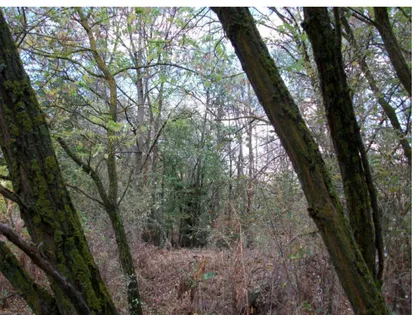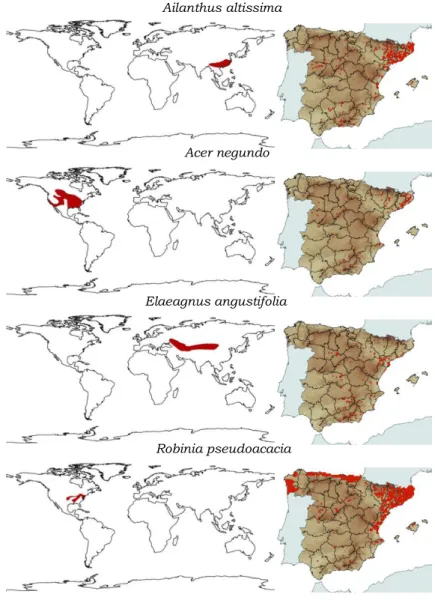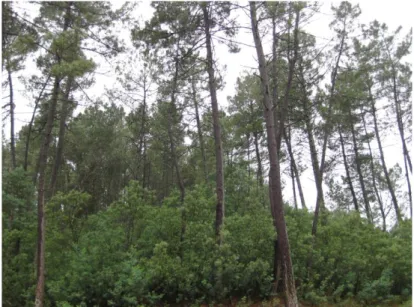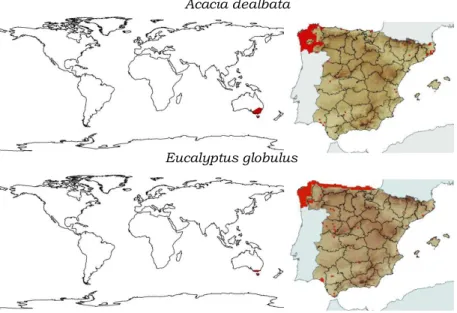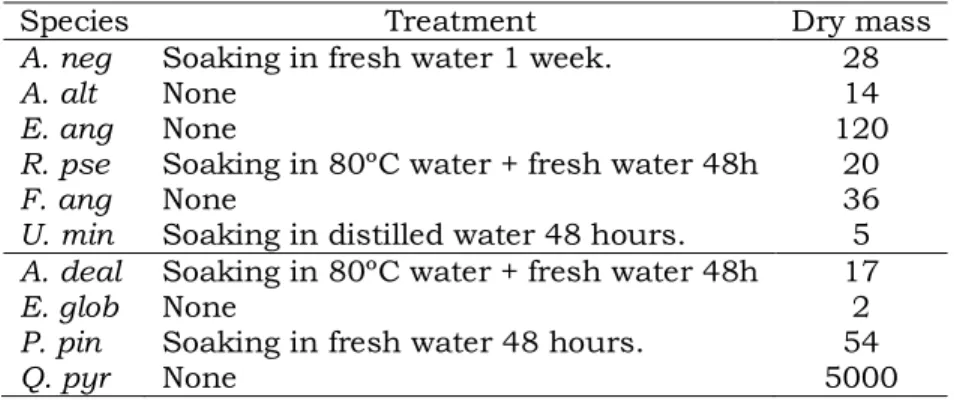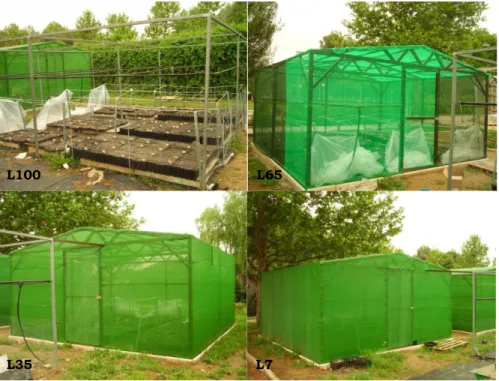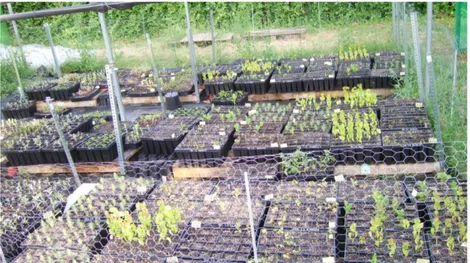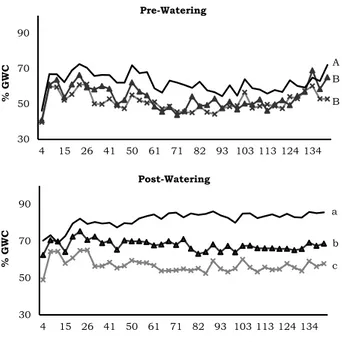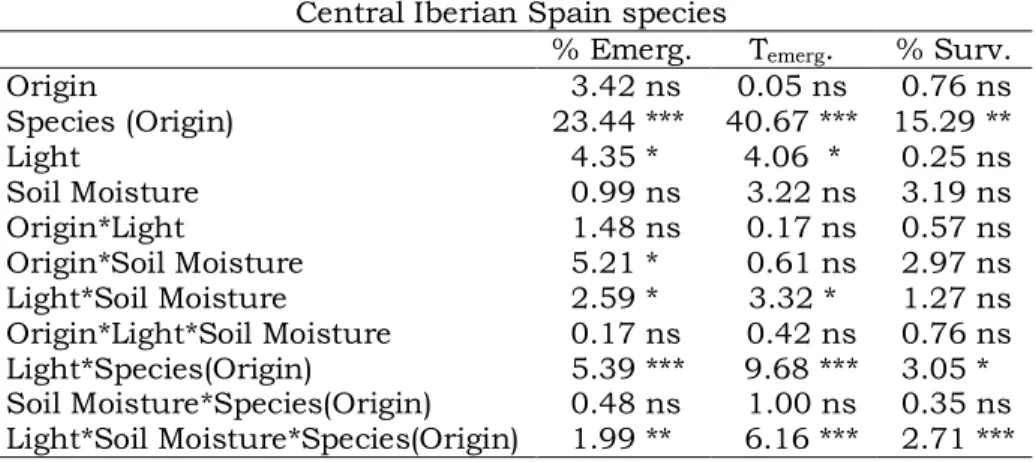TESIS DOCTORAL
DEPARTAMENTO DE ECOLOGÍA
UNIVERSIDAD DE ALCALÁ
2012
NOELIA GONZÁLEZ MUÑOZ
CA
US
ES
AN
D
CO
NS
EQ
UE
NC
ES
O
F E
XO
TIC
TR
EE
IN
VA
SIO
N I
N T
HE
IBE
RIA
N P
EN
INS
UL
A
NO
EL
IA
GO
NZÁ
LE
Z M
UÑ
OZ.
TE
SIS
D
OC
TO
RA
L.
CAUSES AND CONSEQUENCES
OF EXOTIC TREE INVASION
U N I V E R S I D A D D E A L C A L Á , P A T R I M O N I O D E L A H U M A N I D A D
Departamento de Ecología
Pilar Castro Díez, profesora titular del Departamento de
Ecología de la Universidad de Alcalá y directora de esta
Tesis Doctoral,
Hace constar:
Que el trabajo descrito en la presente memoria, titulado
“Causes and consequences of exotic tree invasion in the
Iberian Peninsula”, ha sido realizado bajo su dirección por
Noelia González Muñoz en el Departamento de Ecología de
la Universidad de Alcalá, dentro del Programa de
Doctorado “Ecología, Conservación y Restauración de
Ecosistemas”, reuniendo todos los requisitos necesarios
para su aprobación como Tesis Doctoral.
Alcalá de Henares, 4 de julio de 2012.
U N I V E R S I D A D D E A L C A L Á , P A T R I M O N I O D E L A H U M A N I D A D
Departamento de Ecología
Julio Camargo Benjumeda, director del Departamento de
Ecología de la Universidad de Alcalá,
Hace constar:
Que el trabajo descrito en la presente memoria, titulado
“Causes and consequences of exotic tree invasion in the
Iberian Peninsula”, ha sido realizado dentro del Programa
de Doctorado “Ecología, Conservación y Restauración de
Ecosistemas”, reuniendo todos los requisitos necesarios
para su aprobación como Tesis Doctoral.
Alcalá de Henares, 4 de julio de 2012.
U N I V E R S I D A D D E A L C A L Á , P A T R I M O N I O D E L A H U M A N I D A D
Departamento de Ecología
Causes and consequences of exotic tree
invasion in the Iberian Peninsula
Memoria presentada para optar al grado de
Doctora por la Universidad de Alcalá
Programa de doctorado:
“Ecología, Conservación y Restauración de Ecosistemas”
Noelia González Muñoz
Directora: Pilar Castro Díez
AGRADECIMIENTOS
En primer lugar, gracias a Pilar, por la oportunidad, por la confianza y por la paciencia. Pero, sobre todo, por ser ejemplo a seguir en todos los niveles. Gracias.
Gracias al Departamento de Ecología por hacerme sentir como en casa durante los últimos años. A todos. Gracias al Forest Ecology and Forest Management Group (Wageningen), al Department of Ecology and Evolutionary Biology (Parker Lab, Santa Cruz) y al Department of Ecology, Evolution and Marine Biology (Levine Lab, Santa Bárbara). Y gracias adelantadas al Departamento del Biología Animal, Vegetal y Ecología de la Universidad de Jaén.
Gracias a todas las personas que me han acogido y que se han convertido en mi familia allí donde he ido. En especial, Ute Sass-Klassen, Ellen Wildernick, la familia Poorter, Ingrid Parker, Jonathan Levine y Óscar Godoy. Y gracias a la cohorte de post-doc españoles que me he ido encontrando por el camino y que me han ayudado mucho, muchísimo: José Luis Quero, Cristina Fernández Aragón, Javier Gutiérrez Illán, Laura Domingo, Marta Rueda y, otra vez, Óscar. Vayas donde vayas, ten tu post-doc español.
Pero, sobre todo, gracias a mis compañeros soñadores, de futuros tan inciertos como el mío. Imposible terminar una tesis sin una buena red de amigos, imposible terminar esta tesis sin vosotros. Conmigo, siempre.
Y bueno, como no quiero que se me olvide nadie, ahí va la lista con los nombres de las personas que han estado presentes con su energía, su presencia y su abrazo a lo largo de mi caótica existencia. Sois parte de lo que soy.
me olvida seguro). A las fisios, Ana, Silvia, Patri y Diana, a sus bebés e incluso a sus maridos. A las constructoras de catedrales Sofía y Penélope. A Cris. Y a la mamá de Cris, a quien debo la maqueta de esta tesis. A Álvaro y al bebé Miguel, que nos escuchaba paciente. A Judith, que diseñó la portada. A Vane y a Juan. A Javi Pavón. A Juan Carlos Linares. A Stijn, a Greg, a Juanito. A mis amigos repartidos por el mundo, en especial a Hannah, a Luca y a Tom. A los parisinos. A todas las ciudades en las que he vivido: Wagenigen, Santa Cruz, Santa Bárbara, Madrid. Venga, a Mejorada del Campo, que si no no os quedáis contentos. Y a la
ciudad de París, donde estoy escribiendo estos
agradecimientos.
Y, por supuesto, a ti, Elvis.
“Y así crecí volando y volé tan deprisa que hasta mi propia sombra
de vista me perdió”
Table of Contents
Resumen
Abstract
Chapter 1.
General Introduction.………
1
General Aims.……….
23
Thesis Outline………
24
Chapter 2.
Establishment success of coexisting native
and exotic trees under an experimental gradient of
irradiance
and
soil
moisture………
47
Resumen……….
49
Abstract………
51
1.
Introduction……….
53
2.
Material and Methods………..
56
4.
Discussion………...
76
5.
Conclusions……….
83
6.
Acknowledgements………
83
7.
Bibliography………
84
8.Supplementary Material………
93
Chapter 3.
Assessing seedling growth strategies of
co-occurring native and exotic tree species: an
experiment to identify potential regeneration niches
for exotic trees in human managed riparian
forests..……….
99
Resumen………
101
Abstract………..
103
1. Introduction………..
105
2.
Material and Methods………
109
1.
Results………
117
2.
Discussion……….
126
3.
Conclusions………..
131
4.
Acknowledgements……….
132
5.
Bibliography……….
133
Chapter 4.
Effects of exotic invasive trees on nitrogen
cycling:
a
case
of
study
in
Central
Spain………..
149
Resumen………..
151
Abstract……….
153
1.
Introduction………
155
2.
Material and Methods……….
159
3.
Results……….
168
4.
Discussion………..
180
5.
Conclusions………
186
6.
Acknowledgements………..
186
7.
Bibliography………..
187
8.Supplementary Material………..
197
Chapter 5.
Differences in nitrogen use strategies
between native and exotic tree species: predicting
impacts on invaded ecosystems………
201
Resumen………..
203
Abstract……….
205
1.
Introduction………..
207
2.
Material and Methods………
212
3.
Results………
222
5.
Conclusions………
234
6.
Acknowledgements………..
235
7.
Bibliography………..
236
Chapter 6.
General Conclusions………..
247
Chapter 7.
Future Research Lines………..
253
RESUMEN
Esta Tesis Doctoral se centra en el estudio de especies de árboles exóticos y nativos coexistentes en bosques de ribera del centro de la Península Ibérica y en robledales del Noroeste. Los objetivos principales son: 1) determinar las condiciones ambientales que favorecen el éxito de establecimiento de árboles nativos y exóticos; 2) evaluar los impactos sobre el ciclo de nitrógeno de las especies exóticas del centro peninsular.
Para el objetivo 1, se realizó un experimento de dos años de duración en el que se comparó el éxito de establecimiento entre árboles nativos y exóticos, bajo distintas combinaciones
de tratamientos de luz y de humedad del suelo (Capítulos 2 y
3). Para el objetivo 2, se compararon los efectos sobre el suelo
de la hojarasca de especies nativas y exóticas (Capítulo 4), así
como sus estrategias de uso de nitrógeno (Capítulo 5).
Las especies estudiadas pueden agruparse en base a sus respuestas a los tratamientos ensayados, con independencia de su origen nativo y exótico, debido a la heterogeneidad en las respuestas de las especies incluidas en cada origen.
ABSTRACT
This Thesis is focused in the study of exotic and native tree species co-occurring in the riparian forests of central Spain and in the mesic forests of the Northwest.
The main aims are: 1) determining the environmental conditions that favour the establishment success of native and exotic tree species; 2) evaluating the impacts on the nitrogen cycling of the exotic species spreading in riparian forests of central Spain.
To achieve aim 1, a two year experiment was conducted to compare differences in the establishment success between native and exotic seedlings under different treatments of light and soil moisture (Chapters 2 and 3). To achieve aim 2, we evaluated the effects of exotic and native litter on invaded soils (Chapter 5) and compared differences in nitrogen use
strategies between native and exotic tree species (Chapter 4).
The studied species can be grouped regarding their responses to the light and soil moisture treatments, but independently of their native or exotic origin, due to the heterogeneity found in the responses of the species included in each group.
1
Chapter 1
Chapter 1
General Introduction
3
Biological invasions
Biological invasions are defined as the process of introduction, establishment and spread of exotic species (Williamson and Fitter, 1996; Mack et al., 2000; Richardson et al., 2000; Balaguer, 2004; Vilà et al., 2008). Nowadays, biological invasions are considered not only an economic problem (Perrings et al., 2002; Pimentel et al., 2005), but also one of the biggest threats for biodiversity conservation, only after habitat destruction and fragmentation (Vitousek, 1990; Vitousek et al., 1997; Mack et al., 2000).
Chapter 1
4
In this context, an invasive plant species is that which has been introduced in a new area, being able to successfully establish and spread during a short period of time (Pysek et al., 2004). The process of plant invasion or, in general, of any biological invasion, can be split in four non-discrete stages: transport, colonization, establishment and spread (Sakai et al., 2001; Teoharides and Dukes, 2007) (Fig. 1).
Fig. 1. The four stages in the process of plant invasion and the dominant factors and processes affecting the success in each stage. NIPS (invasive nonindigenous plant species) (taken from Teoharides and Dukes, 2007).
Box 1. Concepts related to invasive species (Vilà et al., 2008).
Exotic: Species original to a foreign area.
Casual/subspontaneous: Species that may reproduce occasionally but whose persistence rely on repeated introductions.
Naturalized: Species that form self-replacing populations.
General Introduction
5
The invasion starts with the transport of a species from its home range to a new territory (Fig. 1). This transport is normally related to human activities. Despite long distance transport has a long history, the pressure of introduction of exotic species has increased during the last 200 hundred
years and, especially, since the beginning of the 20th century,
due to the intensification of transport and business routes (Mack et al., 2000; Vilà, and Pujadas, 2001; Reichard and White, 2001; McNeely et al., 2001). The most relevant traits to pass this filter are those related to survival to transport and to human selection before transport (disease resistance, showy flowers, high amount of seed production, drought tolerance, fast growth, etc.) (Theoharides and Dukes, 2007). The colonization stage starts when the exotic species arrives in the new territory (Fig. 1). At this stage, species success depends on the propagule pressure, the abiotic filters present in the new area (e.g. climate, soil type, resources availability,…) and the biotic filters at neighborhood scale (i.e.
interspecific competition, diseases, predators, etc.)
Chapter 1
6
environment and helps to dominate the seed pool (Williamson and Fitter 1996, Lonsdale, 1999, Colautti et al., 2006;
Lockwood et al., 2009). The establishment stage is normally
longer than the colonization stage, and requires the exotic species to be able to develop self-sustainable populations (Fig. 1). Despite abiotic conditions are still important during this stage, biotic filters, as competitive or facilitative relationships with local flora or other trophic levels (mutualism, herbivory, parasitism, etc.) become more relevant (Theoharides and Dukes, 2007). Finally, to overcome the spread stage and to guarantee the invasion success, the exotic species depend on their dispersal abilities and on landscape characteristics (e.g. habitat connectivity, metapopulation dynamics, disturbance events, etc.) (Fig. 1).
Invasiveness and invasibility
General Introduction
7
The term invasiveness referes to the characteristics of the species that may help an exotic species to successfully invade an ecosystem (Williamson and Fitter, 1996; Sakai et al., 2001; Erfmeier and Bruelheide, 2010). Some plant properties previously related to invasiveness are: high competitive ability (Vilà and Weiner, 2004), the ability to reproduce vegetatively (Richardson and Pysek, 2006; van Kleunen et al., 2007), high growth rate (Grotkopp et al., 2002; van Kleunen et al., 2010; Lamarque et al., 2011), low seed size (Rejmánek and Richardson, 1996; but see Castro Díez et al., 2011), short length of the juvenile period and short interval between seed mast years (Rejmánek and Richardson, 1996) or high phenotypic plasticity (Davison et al., 2011). Besides, different hypotheses have been postulated to explain exotic species
invasiveness as, for instance, the novel weapon hypothesis,
which suggests that the invasion success is related to the
ability to produce allelopathic compounds (Callaway and Aschehoug, 2000; Hierro and Callaway, 2003).
Chapter 1
8
Furthermore, Godoy et al. (2011) did not find a higher plasticity in invasive plants over natives. In this sense, Davison et al. (2011), in a meta-analysis performed with 75 invasive/non-invasive pairs of plant species found that, despite invaders showed an overall higher phenotypic plasticity than natives, natives performed as well or even better than invaders when resources were not abundant. This disparity of results is mainly due to the different contexts in which the invasion occurs, as invasion success is very dependent on the environment.
The term invasibility involves the properties of the recipient ecosystem (Londsdale, 1999; Sakai et al., 2001, Richardson and Pysek, 2006) which may facilitate or hamper the invasion success. There are several hypotheses intending to explain
community invasibility. For instance, the empty niche
hypothesis (Levine and D´Antonio, 1999) suggests that the absence of certain life forms may favor the establishment of exotic species belonging to that life form, which will be able to
exploit a vacant niche. The invasional meltdown hypothesis
(Simberloff and von Holle, 1999) proposes that the success of exotic species is favored by the presence of other exotic species, due to facilitative relationships. By contrast, the
General Introduction
9
disturbance hypothesis (Mack et al., 2000) argues that disturbances may increase resource availability and reset succession, giving native and exotic species the same opportunities to succeed. The fluctuating resource availability hypothesis postulates that the exotic species may take advantage of punctual or recurrent resource liberation in space or time, as it happens after a disturbance (Davis et al.,
2000). The enemy release hypothesis (Keane and Crawley,
2002) proposes that exotic species are favored by the absence of natural enemies in the new territory. Based in this last hypothesis, Blossey and Notzold (1995) postulated the
Chapter 1
10
In spite of the large amount of previous studies explaining potential causes of invasion success, the literature also shows that no single hypothesis is valid for any invasion case. In this
context, several meta-analyses have tested which
General Introduction
11
growth rate was the species trait that better explain exotic tree species success, in agreement with van Kleunen et al. (2010) and Grotkopp et al. (2002).
Despite the increasing information available regarding the biology of invasions, predicting invasion events is still difficult, as it requires a profound knowledge of the history of the species introduction, the species attributes, the characteristic of the invaded habitat and the interaction between them (Catford et al., 2009).
The impacts of plant invasions
Catford et al. (2009) suggested a last stage in the process of biological invasions, the impact stage, in which the invasive species produces harmful consequences on ecology and/or economy.
Chapter 1
12
alien species management had been higher than 50 million euros during the previous decade. According to the European Invasive Alien Species Gateway (DAISIE, www.europe-aliens.org), in 2010 there were 10000 exotic species known in Europe. However, there were only ecological impacts documented for 1094 of them and economic impacts for 1347 (Vilà et al., 2010). In 2012, the last update of the same group of experts compiled 11595 exotic species in Europe. In the list of the 100 most harmful exotic invasive species provided by the DAISIE database are included, for instance, the plant
species Ailanthus altissima (Mill.) Swingle, Acacia dealbata
Link., Carpobrotus edulis (L.), Cortaderia selloana (Schult. & Schult. F.) Asch & Graebn, Opuntia ficus indica L. and Robinia pseudoacacia L., all of them widespread in the Iberian Peninsula.
General Introduction
13
2003; Griffiths et al., 2005; Marchante et al., 2008 and 2009; Malcom et al., 2008; DeCant, 2008; Follstad Sha et al., 2010; Qiu et al., 2010; González Muñoz et al., 2012), the soil community composition (Kourtev et al., 2002; Reinhart and VandeVoort, 2006; Lorenzo et al., 2010c), the water cycle (Zavaleta, 2000; Glenn and Nagler, 2005), the species interactions (Morales and Traveset, 2009; Holmes and Cowling, 1997) and the species community composition (Levine et al., 2003; Yelenik et al., 2004; Hellmann et al., 2011; González Muñoz et al., 2012).
Chapter 1
14
Study cases: Exotic invasive trees in the
Iberian Peninsula
This Thesis is focused on the study of native and exotic tree species co-occurring in two botanically, edaphically and climatically contrasted forests: the inner riparian Peninsula floodplains and the mesic forests of the Northwest
Riparian forests of central Iberian Peninsula
The Mediterranean continental climate is characterized by a
double stress for plant establishment: the low winter temperatures and the summer drought (Mitrakos, 1980). This double stress prevents the establishment of exotic plants not adapted to this climate. However, in alluvial floodplains, the
summer water stress is mitigated by the shallow phreatic table, and by the shade of the dense canopies in non disturbed riparian forest. These circumstances make floodplains more vulnerable to be invaded by exotic species. Indeed, Chytrý et al. (2008, 2009) found that riparian forests, along with coastal areas, are among the most invaded habitats in the Mediterranean regions of Europe. Besides, the natural river dynamic opens gaps after flooding events, favoring the
General Introduction
15
Furthermore, human settlements, which are a source of exotic species, are usually close to rivers, which act as corridors, helping to the propagule dispersion (Richardson et al., 2007).
Our study area in inner Iberian Peninsula were the low stretchs of the alluvial floodplains of the Henares and Manzanares rivers. These forests are dominated by the tree species Fraxinus angustifolia Vahl., Ulmus minor Mill., Populus alba L., Populus nigra L. and different species of the genera
Salix and Tamarix (Blanco Castro et al., 2005). This native vegetation has been severely modified by human activities, such as river regulation, river channelization, agriculture, human disturbance, etc. Nowadays, these riparian forests are widely invaded by the exotic tree species Ailanthus altissima
Mill., Elaeagnus angustifolia L., Acer negundo L., Robinia
Chapter 1
16
Fig. 2. Detail of Robinia pseudoacacia presence in a forest gap at the Henares river floodplain (La Canaleja, Alcalá de Henares).
The studied exotic species are native to very different biogeographic regions and were introduced in the Iberian Peninsula between late 18th to early 20th century, mainly
because of ornamental purposes. Robinia pseudoacacia and A.
General Introduction
17
(Boring and Swank, 1984; Katz and Shafroth, 2003).
Ailanthus altissima bark, roots and leaves have been shown to be strongly allelopathic, able to inhibit other species emergence and growth (Heisey, 1990, 1996; Heisey and Heisey, 2003; de Feo et al., 2005). Besides, all of them produce high amounts of seeds and are able to resprout, favoring their fast spread (Overton, 1990; Katz and Shafroth, 2003; Weber, 2003; Sanz Elorza et al., 2004; Kowarik and Säumel; 2007; Masaka and Yamada, 2009).
Chapter 1
18
Ailanthus altissima
Acer negundo
Elaeagnus angustifolia
Robinia pseudoacacia
Fig. 3. Native range (left) and distribution in Spain (right) (red) of
Ailanthus altissima, Acer negundo, Elaeagnus angustifolia and
General Introduction
19
Mesic forests of Northwestern Iberian Peninsula
The study area in the Northwest of the Iberian Peninsula was located in the surroundings of the city of Orense (Galicia, Spain), in the border of the Eurosiberian and Mediterranean Regions, where the climate is Atlantic with strong Mediterranean influence (Rivas-Martínez, 1987). In this area, native forests have been severely modified by human activities, as forest destruction for timber purposes, or by recurrent fires (Izco, 1987; Blanco Castro et al., 2005).
The native tree vegetation is dominated by Quercus robur L. and Quercus pyrenaica Willd., which form mixed forests with
Castanea sativa Mill., Laurus nobilis L., Quercus suber L.,
Ruscus aculeatus L., Tamus communis L., Rhamnus alaternus
L., Arbutus unedo L., Crataegus monogyna Jaqc. and Ilex aquifolium L., among others (Izco, 1987; Blanco et al., 2005). Along with native mature forests, there are also abundant
plantations of Pinus pinaster Aiton, which has been cultivated
since the 19th century for timber purposes (Blanco et al.,
2005) and, from there, this species has spread to other areas.
Despite P. pinaster has sometimes been considered an exotic
species in this area, paleobotanical and historical sources confirm its autochthonous character in the area (Valdés et al.,
Chapter 1
20
and Eucalyptus globulus Labill are spreading throughout Miño river floodplains, forest borders, road limits and native forest gaps (Fig. 4). Besides, it is also easy to find scattered adult trees of E. globulus in the native forests.
Fig. 4. Detail of a Pinus pinaster forest edge at the province of
Orense with an understory colonized by Acacia dealbata (Orense
province).
Acacia dealbata and E. globulus are native to the Southeast of Australia and were introduced in the Iberian Peninsula in the second half of the 19th century, for ornamental and timber
General Introduction
21
and Ledig, 1990, Babu and Kandasamy, 1997; Carballeira and Reigosa, 1999; Sanz Elorza et al., 2004; Lorenzo et al., 2008; Lorenzo et al. 2010a, 2010b and 2010c; Lorenzo et al., 2011; Lorenzo et al., 2012).
Acacia dealbata
Eucalyptus globulus
Fig. 5. Native range (left) and distribution in Spain (right) of Acacia dealbata and Eucalyptus globulus (taken from Sanz Elorza et al., 2004).
Chapter 1
22
General Introduction
23
General Aims
The general aims of this Thesis are:
1.
Identifying the environmental conditions that favor
exotic tree species establishment success over natives of
both study areas during early life stages.
Chapter 1
24
Thesis Outline
This Thesis is structured in 7 chapters, including this General
Introduction (Chapter 1). Chapters 2 to 5 correspond to
scientific papers written in English and published or sent to
scientific journals. Chapter 6 includes the General
Conclusions of this Thesis. Chapter 7 shows future research lines.
The Thesis Outline will be explained regarding its main objectives.
Aim 1. Identifying the environmental conditions that favor exotic tree species establishment success over natives of both study areas during early life stages.
General Introduction
25
seedling stage, as young plants are more vulnerable to stress factors than adults. In each chapter, different species attributes are compared, in order to get an overview of the environmental conditions that favour co-occurring exotic and invasive tree species performance during their first two growing seasons.
Chapter 2. Establishment success of coexisting native and exotic trees under an experimental gradient of irradiance and soil moisture (Published in Environmental Management (2011), vol. 48(4), pages 764-773).
In this chapter, we experimentally determine the light and soil moisture scenarios that favor or hamper the establishment of co-occurring exotic and native tree species seedlings, by evaluating seedling emergence, time to emergence and survival. The species included in this chapter are the natives
Fraxinus angustifolia, Ulmus minor, Quercus pyrenaica and
Pinus pinaster and the exotics Acer negundo, Ailanthus altissima, Elaeagnus angustifolia, Robinia pseudoacacia,
Chapter 1
26
Chapter 3. Assessing growth strategies of seedlings of co-occurring native and exotic tree species: an experiment to identify potential regeneration niches in human managed riparian forests (sent to Journal of Vegetation Science, 2012).
In this chapter, we compare the biomass reached after the first and the second growing seasons and biomass related traits (biomass allocation, relative growth rate, net assimilation rate per unit of leaf mass) between native and exotic species along an experimental gradient of light and soil moisture. The species included in this chapter are the natives
Fraxinus angustifolia, Ulmus minor and Populus alba and the
exotics Acer negundo, Ailanthus altissima, Elaeagnus
General Introduction
27
Aim 2. Evaluating the effects of exotic trees on the nitrogen cycling of riparian forests of central Spain, in order to predict the impacts on the invaded ecosystems of shifts in native/exotic tree species dominance.
The introduction of exotic species in a territory may lead to changes in the nitrogen cycling of the ecosystems. These changes can be due to differences in the amount and quality of the litter or in differences in nitrogen economies between the native and the exotic species. In this Thesis, we evaluate the impacts of exotic trees on the nitrogen cycling from two
very different approaches. In Chapter 4, we assess the effect of
Chapter 1
28
Chapter 5. Effects of exotic invasive trees on nitrogen cycling: a case study in Central Spain (Published in Biological Invasions
(2009) vol. 11, pages 1973-1986).
We evaluate the effect of Ailanthus altissima and Robinia
pseudoacacia on the nitrogen cycle by comparing leaf litter quality, litter decomposition rates and nitrogen availability in
soils with two co-occurring natives, Fraxinus angustifolia and
Ulmus minor.
Chapter 6. Differences in nitrogen use strategies between native and exotic tree species: predicting impacts on invaded ecosystems (Plant and Soil, 2012. In press).
We compare differences in nitrogen use efficiency and related
traits among three native (Fraxinus angustifolia, Populus alba
General Introduction
29
FUNDS
This Thesis has been supported by the projects CGL2007-61873/BOS and CGL2010-16388/BOS of the Spanish Ministry of Science and Innovation, the project
POII10-0179-4700 of the Junta de Comunidades de Castilla-La Mancha and
REMEDINAL-2 network (Comunidad de Madrid). Noelia
González-Muñoz was supported by a grant of the SMSI (FPI fellowship, BES-2008-002457) and by a grant of Alcalá
University (Ayuda a la iniciación de la Actividad Investigadora).
BIBLIOGRAPHY
Andreu, J., Vilà, M. (2009) Risk analysis of potential invasive plants in Spain. Journal of Nature Conservation 18, 34-44.
Babu, R.C., Kandasamy, O.S. (1997) Allelopathic effect of
Eucalyptus globulus Labill. on Cyperus rotundus L. and
Cynodon dactylon L. Pers. Journal of Agronomy and Crop Science 179,123-126.
Chapter 1
30
Blanco Castro, E., Casado González, M.A., Costa Tenorio, M., Escribano Bombín, R., García Antón, M., Génova Fuster, M., Gómez Manzaneque, M.A., Gómez Manzaneque, F., Moreno Saiz, J.C., Morla Juaristi, C., Regato Pajares, P., Sainz Ollero, H. (2005) Los bosques ibéricos: una interpretación geobotánica. Editorial Planeta, Barcelona.
Blossey, B., Notzold, R. (1995) Evolution of increased competitive ability in invasive non indigenous plants: a hypothesis. Journal of Ecology, 83, 887-889.
Boring, L.R., Swank, W.T. (1984) The role of black locust (Robinia pseudoacacia) in forest sucession. Journal of Ecology 72(3), 749-766.
Bruno, J.F., Stachowicz, J.J., Bertness, M.D. (2003) Inclusion of facilitation into ecological theory. Trends in Ecology and Evolution 18, 119-125.
Callaway, R.M., Aschehoug, E.T. (2000) Invasive plants versus their new and old neighbours: a mechanism for exotic invasion. Science 290, 521-523.
General Introduction
31
Carballeira, A., Reigosa, M.J. (1999) Effects of natural
lecheates of Acacia dealbata Link in Galicia (NW Spain).
Botanical Bulletin Academia Sinica 40, 87-92
Castro-Díez, P., Godoy, O., Saldaña, A., Richardson, D.M. (2011) Predicting invasiveness of Australian acacias on the basis of their native climatic affinities, life history traits and human use. Diversity and Distributions 17(5), 934-945.
Castro-Díez, P., Fierro-Brunnenmeister, N., González-Muñoz, N., Gallardo, A. (2012) Effects of exotic and native tree leaf litter on soil properties of two contrasting sites in
the Iberian Peninsula. Plant and Soil350, 179-191.
Catford, J.A., Jansson, R., Nilsson, Ch. (2009) Reducing redundancy in invasion ecology by integrating hypotheses into a single theoretical framework. Diversity and Distributions 15, 22-40.
Chytrý, M., Maskell, L.C., Pino, J., Pysek, P., Vilà, M., Font, X., Smart, S.M. (2008) Habitat invasions by alien
plants: a quantitative comparison among
Mediterranean, subcontinental and oceanic regions of Europe. Journal of Applied Ecology 45, 448-458.
Chapter 1
32
Colautti, R.I., Grigorovich, I.A., MacIsaac, H.J. (2006) Propagule pressure: a null model for biological invasions. Biological Invasions 8, 1023-1037.
Daehler, C.C. (2003) Performance comparisons of co-occurring native and alien invasive plants: implications for conservation and restoration. Annual Review Ecology Evolution and Systematics 34, 183-211.
Davis, M.A., Grime, J.P., Thompson K. (2000) Fluctuating resources in plant communities: a general theory of invasibility. Journal of Ecology 88, 528-534.
Davidson, A.M., Jennions, M., Nicotra, A.B. (2011) Do invasive species show higher phenotypic plasticity than native species and, if so, is it adaptative? A meta-analysis. Ecology Letters 14, 419-431.
DeCant, J.P. (2008) Russian olive, Elaeagnus angustifolia,
alters patterns in soil nitrogen pools along The Rio Grande River, New Mexico, USA. Wetlands 28(4), 896-904.
de Feo, V., de Martino, L., Santoro, A., Leone, A., Pizza, C., Franceschelli, S., Pascale, M. (2005) Antiproliferative effects of tree-of-heaven (Ailanthus altissima Swingle) Phytotherapy research 19, 226-230.
General Introduction
33
Eppstein, M.J., Molofsky, J. (2007) Invasiveness in plant communities with feedbacks. Ecology Letters 10, 253-263.
Erfmeier, A., Bruelheide, H. (2010) Invasibility or invasiveness? Effects of habitat, genotype, and their
interaction on invasive Rhododendron ponticum
populations. Biological Invasions 12, 657-676.
Follstad Sha, J.J., Harner, M.J., Tibberts, T.M. (2010)
Elaeagnus angustifolia elevates soil inorganic nitrogen pools in riparian ecosystems. Ecosystems 13, 46-61. Glenn, E.W., Nagler, P.L. (2005) Comparative ecophysiology of
Tamarix ramosissima and native trees in western US riparian zones. Journal of Arid Environments 61, 419-446.
Godoy, O., Valladares, F., Castro-Díez, P., Costa, M. (2008) Características de las plantas invasoras. In: Vilá, M., Valladares, F., Traveset, A., Santamaría, L., Castro-Díez, P. (Eds.) Invasiones Biológicas. CSIC, Madrid. Godoy, O., Valladares, F., Castro-Díez, P. (2011) Multispecies
Chapter 1
34
González-Muñoz, N., Costa-Tenorio, M., Espigares, T. (2012) Invasion of Acacia dealbata on Quercus robur forests: Impacts on soils and vegetation. Forest Ecology and Management 269, 214-221.
Griffiths, R., Madritch, M., Swanson, A. (2005) Conifer
invasion of forest meadows transforms soil
characteristics in the Pacific Northwest. Forest Ecology and Management 208, 347-358.
Grotkopp, E., Rejmánek, M., Rost, T.L. (2002) Toward a causal explanation of plant invasiveness: seedling growth and life-history strategies of 29 pine (Pinus) species. The American Naturalist 159, 396-419.
Gulezian, P.Z., Nyberg, D.W. (2010) Distribution of invasive plants in a spatially structured urban landscape. Landscape and Urban Planning 95(4), 161−168.
Hansen, M., Clevenger, A.P. (2005) The influence of disturbances and habitat on the frequency of non-native plant species along transportation corridors. Biological Conservation 125, 249−259.
General Introduction
35
Heisey, R.M. (1996) Identification of an allelopathic compound
from Ailanthus altissima (Simaroubaceae) and
characterization of its herbicidal activity. American Journal of Botany 83(2), 192-200.
Heisey, R.M, Heisey, T.K. (2003) Herbicidal effects under field
conditions of Ailanthus altissima bark extract which
contains ailanthone. Plant and Soil 256, 85-99.
Hellmann, C., Sutter, R., Rascher, K.G., Máguas, C., Correia, O., Werner, C. (2011) Impact of an exotic N2-fixing
Acacia on composition and N status of a native Mediterranean community. Acta Oecologica 37, 43-50. Hierro, J.L., Callaway R.M. (2003) Allelopathy and exotic plant
invasions. Plant and Soil 256, 29-39.
Hitchmough, J. (2011) Exotic plants and plantings in the sustainable, designed urban landscape. Landscape and Urban Planning 100(4), 380−382.
Hobbs, R.J., Huenneke, L.F. (1992) Disturbance, diversity,
and invasion: Implications for conservation.
Conservation Biology 6(2), 324-337.
Holmes, P.M., Cowling, R.M. (1997) The effects of invasion by
Chapter 1
36
IPCC (2007). Climate change 2007, the physical science basis. Contribution of Working Group I to the Fourth Assessment Report of the Intergovernmental Panel on
Climate Change. Cambridge University Press,
Cambrigde.
Izco, J. (1987) Galicia. In: Peinado-Lorca, M. and Rivas-Martínez, S. (Eds.) La Vegetación de España. Colección Aula Abierta. Universidad de Alcalá, Madrid.
Katz, GL., Shafroth, PB. (2003) Biology, ecology and
management of Elaeagnus angustifolia, L. (Russian
olive) in western North America. Wetlands 23, 763-777. Keane, R.M., Crawley, M.J. (2002) Exotic plant invasions and
the enemy release hypothesis. Trends in Ecology, Evolution and Systematics 17, 164-170.
Kourtev, P.S., Ehrenfeld, J.G., Haggblom, M. (2002) Exotic plant species alter the microbial community structure and function in the soil. Ecology 83(11), 3152-3166. Kowarik, I. (1983) Colonization by the tree of heaven
(Ailanthus altissima) in the French mediterranean region (Bas-Languedoc) and its phytosociological characteristics. Phytocoenologia 11(3), 389-405.
Kowarik, I., Säumel, I. (2007) Biological flora of Central
Europe: Ailanthus altissima (Mill) Swingle. Perspectives
General Introduction
37
Lamarque, L.J., Delzon, S., Lortie, C.J. (2011) Tree invasions: a comparative test of the dominant hypotheses and functional traits. Biological Invasions 13, 1969-1989. Levine, J.M., D´Antonio, C.M. (1999) Elton revisited: a review
of evidence linking diversity and invasibility. Oikos 87, 15-26.
Levine, J.M., Vilà, M., D´Antonio, C.M., Dukes, J.S., Grigulis, S.L. (2003) Mechanisms underlying the impacts of exotic plant invasions. Proceedings of the Royal Society of Biological Sciences 270, 775-781.
Lockwood, J.L., Blackburn, T.M., Cassey, P. (2009) The more you introduce the more you get: the role of colonization and propagule pressure in invasion ecology. Diversity and Distributions 15, 904−910.
Lonsdale, W.M. (1999) Global patterns of plant invasions and the concept of invasibility. Ecology 80, 1522-1536. Lorenzo, P., Pazos-Malvido, E., González, L., Reigosa, M.J.
(2008) Allelopathic interference of invasive Acacia
dealbata: physiological effects. Allelopathy Journal 22, 452-462.
Lorenzo, P., González, L., Reigosa, M.J. (2010a) The genus
Chapter 1
38
Lorenzo, P., Pazos-Malvido, E., Reigosa, M.J., Gonzalez, L.
(2010b) Differential responses to allelopathic
compounds released by the invasive Acacia dealbata
Link (Mimosaceae) indicate stimulation of its own seed.
Australian Journal of Botany 58(7), 546-553.
Lorenzo, P., Rodríguez-Echevarría, S., González, L., Freitas, H.
(2010c) Effects of invasive Acacia dealbata Link on soil
microorganisms as determined by PCR-DGGE. Applied Soil Ecology 44(3), 245-251.
Lorenzo, P., Palomera-Pérez, A., Reigosa, M.J. (2011)
Allelopathic interference of invasive Acacia dealbata
Link on the physiological parameters of native understory species. Plant Ecology 212(3), 403-412. Lorenzo, P., Pazos-Malvido, E., Reigosa, M.J., González, L.
(2012) New sloped box method to study allelopathic
effects of Acacia dealbata under competitive
interactions. Allelopathy Journal 29(2), 271-285.
Mack, R.N., Simberloff, D., Lonsdale, W.M., Evans, H., Clout, M., Bazzaz, F. (2000) Biotic invasions: causes, epidemiology, global consequences and control. Ecological Applications 10, 689-710.
Malcom, G.M., Bush, D.S., Rice, S.K. (2008) Soil nitrogen conditions approach preinvasion levels following
General Introduction
39
pseudoacacia) stands in Pine-oak ecosystem. Restoration Ecology 16(1), 70-78.
Marchante, E., Kjoller, A., Struwe, S., Freitas, H. (2008) Short- and long-term impacts of Acacia longifolia invasion on the belowground processes of a Mediterranean coastal dune ecosystem. Applied Soil Ecology 40, 210-217. Marchante, E., Kjoller, A., Struwe, S., Freitas, H.S. (2009) Soil
recovery after removal of the N2-fixing invasive Acacia
longifolia: consequences for ecosystem restoration. Biological Invasions 11, 813-823.
Maron, J., Vila, M. (2001) When do herbivores affect plant invasion? Evidence for the natural enemies and biotic resistance hypothesis. Oikos 95, 361-373.
Masaka, K., Yamada, K. (2009) Variation in germination
character of Robinia pseudoacacia L. (Leguminosae)
seeds at individual tree level. Journal of Forest Restoration 14, 167-177.
May, B.M., Attiwill, P.M. (2003) Nitrogen-fixation by Acacia
dealbata and changes in soil properties 5 years after mechanical disturbance or slash -burning following timber harvest. Forest Ecology and Management 181, 339-355.
Chapter 1
40
Mineau, M.M., Baxter, C.V., Marcadelli, A.M. (2011) A
non-native riparian tree (Elaeagnus angustifolia) changes
nutrient dynamics in streams. Ecosystems 14, 353-365.
Mitrakos, K.A. (1980) A theory for Mediterranean plant life. Acta Oecologia 1, 245-252.
Morales, C.L., Traveset, A. (2009) A meta-analysis of impacts of alien vs. native plants on pollinator visitation and reproductive success of co-flowering native plants. Ecology Letters 12, 1-13.
Overton, R.P. (1990) Acer negundo. In: Burns, RM., Honkala.,
BH. (Eds) Silvics of North America 2: Hardwoods. Agriculture Handbook 654. U.S. Department of Agriculture, Forest Service, Washington DC.
Parker, I.M., Simberloff, D., Londsdale, W.M., Goodell, K., Wonham, M., Kareiva, P.M., Williamson, M.H., Von Holle, B., Moyle, P.B., Byers, J.E., Goldwasser, L. (1999) Impact: toward a framework for understanding the ecological effects of invaders. Biological invasions 1, 3-19.
General Introduction
41
Pimentel, D., Zúniga, R., Morrison D. (2005) Update on the environmental and the economic costs associated with alien-invasive species in the United States. Ecological Economics 52, 273-288.
Pysek, P., Richardson, D.M., Rejmánek, M., Webster, G., Williamson, M., Kirschner, J. (2004) Alien plants in checklists and floras: towards better communication between taxonomists and ecologists. Taxon 53, 131– 143.
Pysek, P., Richardson, D.M. (2010) Invasive species, environmental change and management, and health. Annual Review of Environment and Resources 35, 25-55.
Qiu, L., Zhang, X., Cheng., J., Xianqiang, Y. (2010) Effects of
black locust (Robinia pseudoacacia) on soil properties in
the loessial gully region of the Loess Plateau, China. Plant and Soil 332, 207-217.
Reichard, S.H., White, P. (2001) Horticulture as a pathway of invasive plant introductions in the United States. Bioscience 51 (2), 103-113.
Chapter 1
42
Rice, S.K., Westerman, B., Federici, R. (2004) Impacts of the
exotic, nitrogen-fixing black locust (Robinia
pseudoacacia) on nitrogen cycling in a pine-oak ecosystem. Ecology 174(1), 97-107.
Richardson, D.M., Allsopp, N., D’Antonio, C.M., Milton, S.J., Rejmánek, M. (2000) Plant invasions: the role of mutualisms. Biological Review 7, 65-93.
Richardson, D., Pysek, P. (2006) Plant invasions: merging the concepts of species invasiveness and community invasivility. Progress in Physical Geography 30(3), 409-431.
Richardson, D., Holmes, P.M., Esler, K.J., Galatowitsch, SM., Stromberg, J.C., Kirkman, S.P., Pysek, P., Hobbs, R.J. (2007) Riparian Vegetation: degradation, alien plant invasions, and restoration prospects. Diversity and Distributions 13, 126-139.
Rivas Martínez, S. (1987) Memoria del mapa de series de vegetación de España 1: 400.000. ICONA. Ministerio de Agricultura, Pesca y Alimentación, Madrid.
General Introduction
43
Sanz Elorza, M., Dana Sánchez, E.D., Sobrino Vespertinas, E. (2004) Atlas de plantas alóctonas invasoras en España. Ministerio de Medio Ambiente, Madrid.
Simberloff, D., von Holle, B. (1999) Positive interactions of nonindigenous species: invasional meltdown? Biological Invasions 1, 21-32.
Skolmen, R.G., Ledig, F.T. (1990) Bluegum Eucalyptus. In:
Burns, RM., Honkala., BH. (Eds) Silvics of North America 2: Hardwoods. Agriculture Handbook 654. U.S. Department of Agriculture, Forest Service, Washington DC.
Souto, XC., Bolaño, JC., González, L., Reigosa, MJ. (2001) Allelopathic effects of tree species on some soil microbial populations and herbaceous plants. Biologia Plantarum 44 (2), 269-275.
Teoharides, K.A., Dukes, J.S. (2007) Plant invasion across space and time: factors affecting non-indigenous species success during four stages of invasion. New Phytologist 176, 256-273.
Valdés, B., Talavera, S., Fernández-Galiano, E. (1987) Flora Vascular de Andalucía Occidental. Ketres, Barcelona. van Kleunen, M., Johnson, S.D., Fischer, M. (2007) Predicting
naturalization of Southern African Iridaceae in other
Chapter 1
44
van Kleunen, M., Weber, E., Fischer, M. (2010) A meta-analysis of trait differences between invasive and non-invasive plant species. Ecology Letters 13, 235-245. Vilà, M., Pujadas, J. (2001) Land-use and socio-economic
correlates of plant invasions in European and North African countries. Biological Conservation 100, 397-401.
Vilà, M., Weiner, J. (2004) Are invasive plant species better competitors tan native plant species? Evidence from pair-wise experiments. Oikos 105, 229-238.
Vilà, M., Castro-Díez, P., García-Berthou, E. (2008) ¿Qué son las invasiones biológicas? In: Vilá, M., Valladares, F., Traveset, A., Santamaría, L., Castro-Díez, P. (Eds.) Invasiones Biológicas. CSIC, Madrid.
Vilà, M., Basnou, C., Pysek, P., Josefsson, M., Genovesi, P., Gollasch, S., Nentwig, W., Olenin, S., Roques, A., Roy, D., Hulme, P.E., DAISIE patterns (2010) How well do we understand the impacts of alien species on ecosystem services? A pan-European, cross-taxa assessment. Frontiers in Ecology and the Environment 8(3), 135-144.
General Introduction
45
Vitousek, P.M. (1990) Biological invasions and ecosystem processes: towards an integration of population biology and ecosystem studies. Oikos 57, 7-13.
Weber, E. (2003) Invasive plant species of the world. A reference guide to environmental weeds. CABI Publishing, Zurich
Williamson, M., Fitter, A. (1996) The varying success of invaders. Ecology. 77(6), 1661-1666.
Yelenik, S.G., Stock, W.D., Richardson, D.M. (2004) Ecosystem level impacts of invasive Acacia saligna in the South African fynbos. Restoration Ecology 12(1), 44-51.
Zavaleta, E. (2000) Valuing ecosystem services lost to Tamarix
47
Chapter 2
Establishment
success
of
coexisting native and exotic trees
under an experimental gradient of
irradiance and soil moisture.
Chapter 2
Establishment success of coexisting native and exotic trees
49
RESUMEN
Los árboles exóticos Ailanthus altissima, Robinia
pseudoacacia, Acer negundo y Elaeagnus angustifolia
coexisten con los árboles nativos Fraxinus angustifolia y
Ulmus minor, entre otros, en llanuras aluviales del centro de la
Península Ibérica. A su vez, los árboles exóticos Acacia
dealbata y Eucalyptus globulus coexisten con los nativos
Quercus pyrenaica y Pinus pinaster en el noroeste peninsular. El objetivo de este capítulo es identificar las condiciones ambientales que favorecen el éxito de establecimiento de estas especies durante la primera estación de crecimiento. Para ello, en primavera de 2008, se sembraron semillas de estas especies bajo cuatro tratamientos de luz (100, 65, 35, 7% respecto de la radiación solar incidente) combinados con tres niveles de riego (Ψw= -0.97, -1.52 y -1.77 MPa). Durante la
primera estación de crecimiento, se monitorizaron emergencia y supervivencia de plántulas. El efecto de los tratamientos de luz en el éxito de establecimiento fue mayor que el de los tratamientos de riego. Entre las especies del centro peninsular, A. negundo fue la especie más tolerante a la
Chapter 2
50
angustifolia y A. altissima. Además, de acuerdo a nuestros resultados, A. dealbata y P. pinaster pueden ser competidores potenciales para la colonización de escenarios altamente irradiados, mientras que Q. pyrenaica y E. globulus lo serían en escenarios más sombreados. Por último, una alta humedad del suelo favoreció el establecimiento de E. globulus, pero perjudicó el de A. dealbata. Nuestros resultados ayudan a definir las condiciones ambientales de luz y humedad del suelo que controlan la segregación espacial de los árboles exóticos y nativos estudiados, pudiendo orientar en la toma de aquellas decisiones dirigidas al control y manejo de estas especies exóticas.
Establishment success of coexisting native and exotic trees
51
ABSTRACT
The exotic trees Ailanthus altissima, Robinia pseudoacacia,
Acer negundo and Elaeagnus angustifolia coexist with the native trees Fraxinus angustifolia and Ulmus minor in river
banks of central Spain. Similarly, the exotic trees Acacia
dealbata and Eucalyptus globulus co-occur with the natives
Quercus pyrenaica and Pinus pinaster in northwestern Spain. We aim to identify the environmental conditions that favour or hamper the establishment success of these species during their first growing season. In spring 2008, seeds of the studied species were sown under an experimental gradient of light (100, 65, 35, 7% of full sunlight) combined with three levels of soil moisture (Ψw= -0.97, -1.52 and -1.77 MPa). During the
first growing season, we monitored seed emergence and seedling survival. We found that the effect of light on the establishment success was stronger than the effect of soil
moisture. Both exotic and native species of central Spain
showed a good performance under high light, A. negundo
being the most shade tolerant. Water shortage diminished E.
Chapter 2
52
competitors for colonizing high-irradiance scenarios, while Q.
pyrenaica and E. globulus were more successful under moderate shade. High soil moisture favoured E. globulus but not A. dealbata establishment. These results contribute to understand some of the factors controlling for spatial segregation between coexisting native and exotic tree species, and can help to take decisions orientated to the control and management of these exotic species.
Establishment success of coexisting native and exotic trees
53
1.
INTRODUCTION
Understanding the differences between coexisting exotic and native species in their seedling responses to resource availability can help us to explain future shifts in species distribution. During the establishment phase, young seedlings are more vulnerable to stress factors, such as low or high irradiance, water shortage, etc., which, in the long term, determine species distribution in the landscape (Niinemets and Valladares, 2006). Therefore, knowing the species requirements during their earlier stage can help us to identify which circumstances can favour exotic species and represent a risk for native ecosystems.
The Mediterranean region is characterised by a double stress for plant establishment and growth: drought summers and cold winters (Mitrakos, 1980; Orshan, 1989). This double stress is highly limiting for plant performance, preventing the
establishment of many exotic plants (Chytrý et al., 2008).
Chapter 2
54
The tree species Ailanthus altissima (Mill.) Swingle, Acer
negundo L., Elaeagnus angustifolia L., Robinia pseudoacacia
L., Eucalyptus globulus Labill and Acacia dealbata Link have been recognized as invasive species and are currently spreading worldwide, especially in areas where the natural vegetation has been disturbed by human activities (DAISIE database (http://www.europe-aliens.org); Weber, 2003; Sanz-Elorza et al., 2004). In the Iberian Peninsula, the first four species are spreading through river banks of the continental inner Spain, where they coexist with native riparian trees, such as Populus spp., Fraxinus angustifolia Vahl and Ulmus minor Mill. These habitats are characterised by nutrient-rich soils, due to the deposition of alluvial sediments and by a higher water table, which alleviates the effect of summer drought. E. globulus and A. dealbata are spreading in more oceanic regions of Northwestern Spain, where they can
compete with the natives Pinus pinaster Aiton. and Quercus
pyrenaica Willd., among others. In this region winter cold is mitigated by the oceanic influence. Despite some of these species have been introduced in the Iberian Peninsula since
the 18th century (Sanz Elorza et al., 2004), the environmental
Establishment success of coexisting native and exotic trees
55
The aim of this study was to identify those environmental conditions that favour or hamper the establishment of coexisting exotic and native trees, well-represented in the Iberian Peninsula. This information can help to assess the invasive risk of the selected exotic trees and provide scientific grounds for their management. Particularly we focused on light and soil moisture conditions, as these factors have been considered the main drivers of plant distribution in ecosystems (Niinemets and Valladares, 2006). Besides, the availability of light and soil moisture is being altered by human activities (Valladares, 2004a). We measured establishment success in terms of seed emergence, number of days needed to emerge (Temerg.) and survival during the first
growing season, as these traits have been previously found to be related with invasion success (Erfmeier and Bruelheide, 2005; Pysek and Richardson, 2007; Perglová et al., 2009; Ferreras and Galetto, 2010).
Chapter 2
56
light availability (hypothesis 2), as corresponds with the ruderal strategy, claimed by many authors as typical of most invasive plant species (Pattison et al., 1998; Baruch and Bilbao, 1999; Daehler, 2003; Grotkopp and Rejmánek, 2007).
2.
MATERIAL AND METHODS
2.1. Experimental design
We conducted a factorial design experiment with three independent factors: irradiance, soil moisture and tree species. The experiment was settled outdoors at the Botanical Garden Juan Carlos I at Alcalá University (Madrid, central Spain 40º30´N, 3º20´W, 596 m a.s.l) from 30th April to 30th
September 2008. In this area the climate is continental Mediterranean with hot and dry summers and cold winters. Mean annual maximum and minimum temperatures are 20.5 and 7.8 ºC, respectively. Mean annual precipitation is 378 mm (data from Torrejón de Ardoz weather station, Instituto Nacional de Meteorología, 1971-2000).
The exotic tree species were selected among those compiled in
the Atlas of the Invasive Alien Species in Spain (Sanz Elorzaet
Establishment success of coexisting native and exotic trees
57
criterion of coexistence in natural areas with the previously selected exotic species. The exotic trees Ailanthus altissima
(Simabouracea), Acer negundo (Sapindaceae), Elaeagnus angustifolia (Eleagnaceae) and Robinia pseudoacacia
(Fabaceae) were introduced from between 18th and 20th
centuries in the Iberian Peninsula (Sanz Elorza et al., 2004).
Nowadays, these species are naturalized in floodplains, crop
and road edges in central Spain, where they coexist with native trees, such as Fraxinus angustifolia (Oleaceae), Ulmus minor (Ulmaceae) and Populus alba (Salicaceae) (Sanz Elorza et al., 2004). The exotic trees Eucalyptus globulus (Myrtaceae) and Acacia dealbata (Fabaceae) were introduced in the mid early 19th century in the Northwest of the Iberian Peninsula
and, currently, they occupy areas where the native forest has
been totally or partially removed (Sanz Elorza et al., 2004). In
this area, the extensive deforestation produced by recurrent fires or by agriculture activities may have increased the chances for exotic tree establishment.
Seeds of all species above were supplied by the Dirección
General para la Biodiversidad (Government of Spain) and
Chapter 2
58
wild to soften their coats and allow hydration and subsequent emergence (Catalán Bachiller, 1993; García-Fayos, 2001; Piotto and Di Noi, 2001). Germination treatments finally used in this experiment were those producing the highest percentage of emergence in the previous essays. A pool of 30 seeds of each species was weighed after > 72 hours in oven at 60ºC (Table 1).
Table 1. Germination pre-treatments used in each species. Average seed dry mass (mg, N=30).
Species Treatment Dry mass
A. neg Soaking in fresh water 1 week. 28
A. alt None 14
E. ang None 120
R. pse Soaking in 80ºC water + fresh water 48h 20
F. ang None 36
U. min Soaking in distilled water 48 hours. 5
A. deal Soaking in 80ºC water + fresh water 48h 17
E. glob None 2
P. pin Soaking in fresh water 48 hours. 54
Q. pyr None 5000
Establishment success of coexisting native and exotic trees
59
the light gradient existing in a typical Mediterranean forest from the gaps (L100) to the under-canopies of dense forests (L7) (Valladares 2004a; Valladares 2004b) (Fig. 1). Soil moisture levels were selected on the basis of our previous experience (Castro-Díez et al., 2006, 2007), intending to induce changes in species success without causing massive mortality (see Fig. 2 for details of how the soil moisture treatments were placed in each light treatment).
L100 L65
L35 L7
Chapter 2
60
Before the beginning of the experiment, we conducted a calibration to determine the amount of water needed to keep the target soil moisture in each treatment. Ten experimental trays (the same where the seeds were sown, see below) were filled with experimental soil (1:2 volume mixture of washed river sand and commercial substrate 15-10-20 NPK- Kekkilä Iberia S.L., Valencia, Spain), watered to field capacity and weighed. Trays were left to evaporate outdoors, being weighed at different times. Once the tray weight reached 40% of the initial weight, they were dried in the oven (>72 h at 60ºC) to get the soil dry weight. The gravimetric soil water content at each weighing was calculated as the percentage of water weight with respect to the soil dry weight. The gravimetric soil water content was plotted against the tray weight to calculate the weight that experimental trays should keep in each soil moisture treatment. We considered the mass of seeds and seedlings negligible. We also estimated the soil matric
potential (Ψm) corresponding to each soil water treatment
Establishment success of coexisting native and exotic trees
61
On 2008 April the 30th, we sowed the seeds of all species.
Species with large seeds were sown in multi-pot trays (24 pots of 330 ml per tray, one seed per pot). Species with small seeds or with low percentages of emergence in the germination essays were sown in single trays (28x38x7 cm, 40 seeds per
tray). In the case of Eucalyptus globulus, given the small seed
size and the low emergence obtained in the germination essays (2%), we sow a known weight of seeds (5-9 g), corresponding to 1500-2700 seeds per tray. As seeds emerged they were removed until a maximum of 100 seedlings per tray, in order to avoid competition-induced mortality.
Fig. 2. Detail of how the three soil moisture treatments were placed at the L100 treatment (Botanical Garden Juan Carlos I, Alcala
